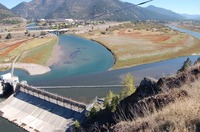 For over 70 years, the Clark Fork River was used as the dumping ground for the waste from one of the largest mining ventures on earth. The companies operating the mines and smelters in Butte and Anaconda unloaded metals-laced tailings directly into the headwaters of the Clark Fork River. The tailings contain arsenic and heavy metals, such as cadmium, copper, iron, lead, manganese, mercury, and zinc. These metals were carried downstream, distributed over the floodplain, and deposited in the reservoir behind Milltown Dam (built in 1908) just upstream of Missoula. The heavy metals in the Milltown Reservoir were found in drinking water wells in nearby towns like Milltown, Bonner, and West Riverside. They were also intruding into the Missoula aquifer, the sole source for municipal drinking water for the city.
For over 70 years, the Clark Fork River was used as the dumping ground for the waste from one of the largest mining ventures on earth. The companies operating the mines and smelters in Butte and Anaconda unloaded metals-laced tailings directly into the headwaters of the Clark Fork River. The tailings contain arsenic and heavy metals, such as cadmium, copper, iron, lead, manganese, mercury, and zinc. These metals were carried downstream, distributed over the floodplain, and deposited in the reservoir behind Milltown Dam (built in 1908) just upstream of Missoula. The heavy metals in the Milltown Reservoir were found in drinking water wells in nearby towns like Milltown, Bonner, and West Riverside. They were also intruding into the Missoula aquifer, the sole source for municipal drinking water for the city.
A legal battle began in 1989 between the EPA and the owner of the upstream mine about its impacts (Atlantic Ridgefield Company), regarding clean-up funding. The Clark Fork floodplain, from Butte to Missoula, became the largest Superfund cleanup site in the Nation. The EPA, Atlantic Ridgefield (AR), and the state of MT settled their dispute regarding the clean-up of the Upper watershed throughout the 1998-2005 period and cleanup began. They then began negotiations with the owner of Milltown Dam regarding the dam and the sediments that it had trapped.
Cracks in the spillway apron at the dam indicated wear and tear on this century-old, timber crib dam. The likely cause was settling and deterioration of the nearly 100-year old timbers used to build the dam, undercutting ad erosion resulting in large cracks that channel water through the timer crib and into visible water spouts at the base of the spillway. Undercutting and erosion were documented in previous dam safety inspections. As a result,the FERC classified the Milltown Dam as a High Hazard Dam. The safety inspection completed by the Licensee’s independent consultant calculated safety factors less than minimum the FERC recommended factors of safety for earthquakes, floods and ice jams. The north half of the dam was not built on bedrock. Instead it is built on riverbed sands and gravels, which are subject to erosion during large floods.
To protect against large floods, the Licensee originally recommended construction of a new, 30-foot high earthen dam extending all the way from the current dam site to the Interstate Highway. This new dam would not only have been be unsightly, but would have blocked traditional public recreation access to the reservoir. The Licensee admitted that the top structure of the dam would be in jeopardy during future ice jams.
Local stakeholders, including American Whitewater, vehemently opposed this proposal. Local support for removal of the sediment behind the dam, and the dam itself mounted. A regulatory battle ensued at the Federal Energy Regulatory Commission over the fate of the dam. AW was an active participant in the back-and-forth regarding the dam's fate, and was a strong proponent of removal. Once dam removal was secured with FERC, and sediment cleanup became the priority, American Whitewater played a more limited role.
The FERC proceedings, coupled with local sentiment and the ongoing superfund negotiations eventually lead to the conclusion that the dam and the sediments should be removed. A plan was developed to drain the reservoir, redirect the Clark Fork River through a lined bypass channel, remove the sediment, remove the dam and powerhouse, and ultimately the creation of a new restored Clark Fork river channel and floodplain in the previous reservoir site. The sediment would be taken upstream to a closed basin repository by train. Removal activities began following the March 2006 Consent Decree between the parties.
The past few years have been extremely busy and the project will continue for the next several years - at least. The State of Montana, the EPA, and Missoula County have played major positive roles in guiding and designing this massive project. Local residents have participated in countless public meetings and are developing a vision for their towns and the former reservoir site. One organization deserves special mention - and credit - for championing this project for its entire duration: the Clark Fork Coalition. American Whitewater produced a time lapse video showing the day the river was restored to its free-flowing condition.
